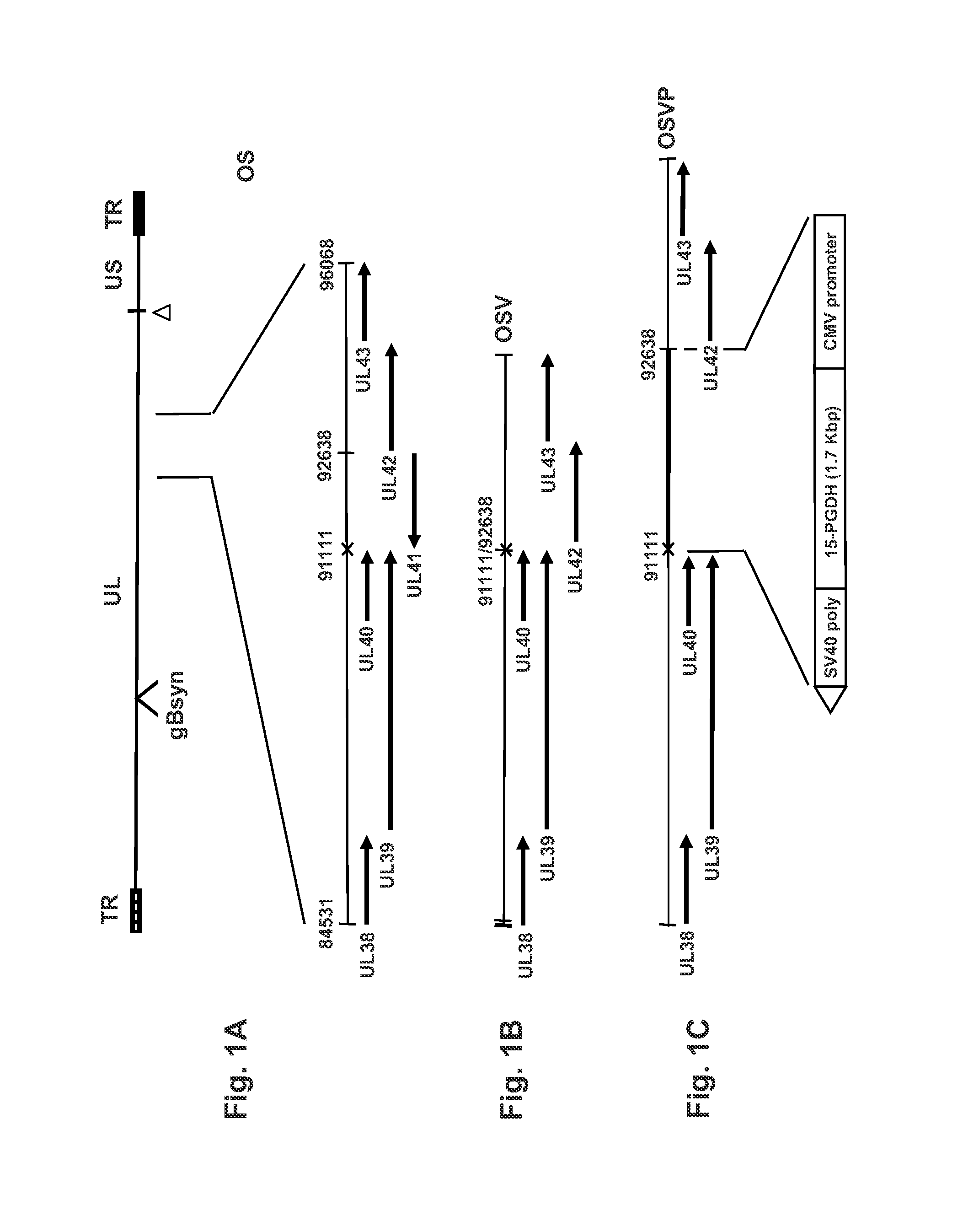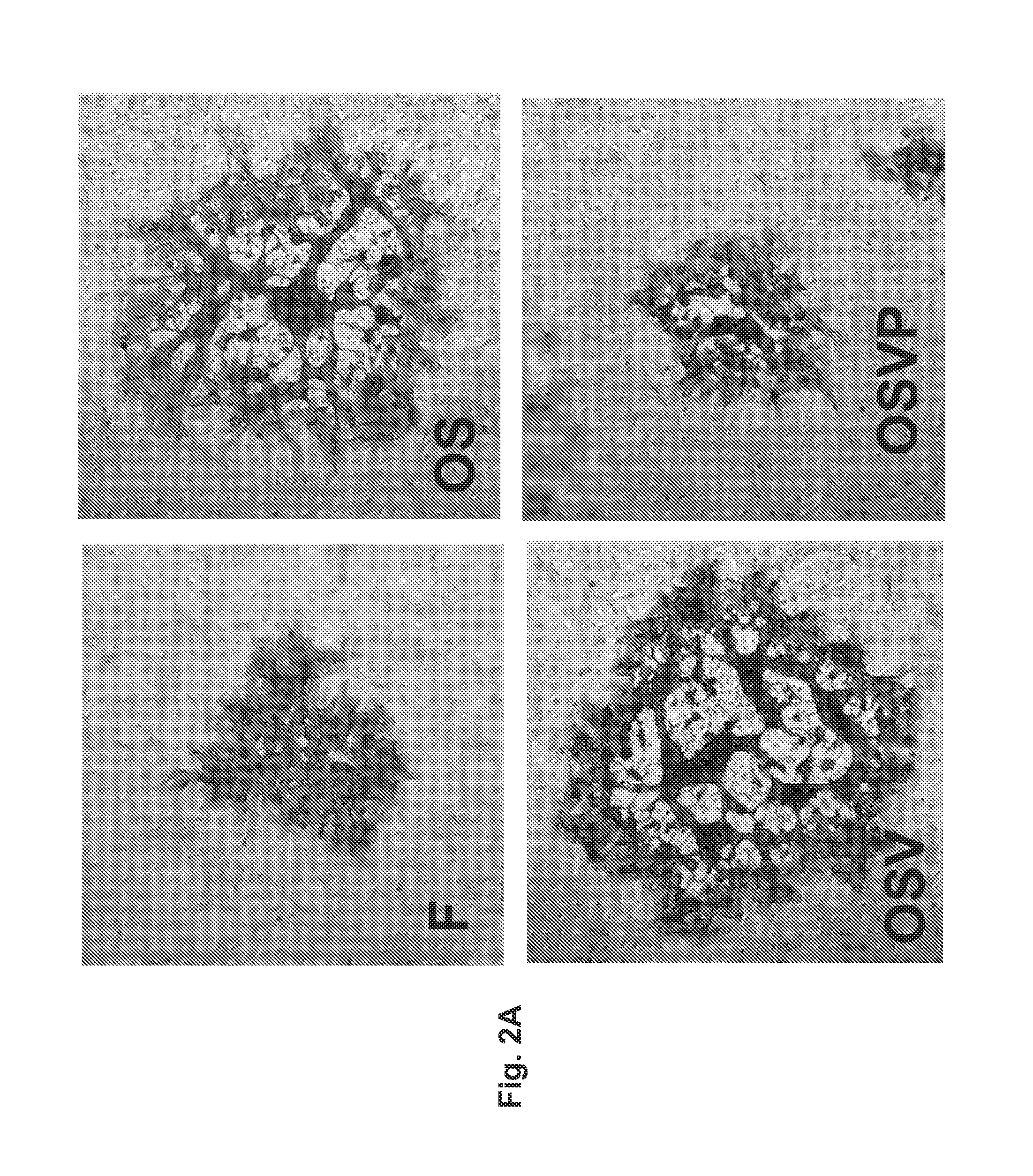Synthetic Herpes Simplex Viruses for Treatment of Cancers
- Summary
- Abstract
- Description
- Claims
- Application Information
AI Technical Summary
Benefits of technology
Problems solved by technology
Method used
Image
Examples
example 1
The OncSyn (OS) Virus
Synthesis
[0039]Cells, viruses and plasmids. African green monkey kidney (Vero) cells, human breast cancer cells (Hs578T), and mouse mammary tumor cells (4T1) (1) were obtained from the American Type Culture Collection (Manassas, Va.). The human breast adenocarcinoma line MDA-MB-435-luc expressing luciferase (MM4L) was kindly provided by Dr. C. Leuschner (Pennington Biomedical Research Center, Baton Rouge, La.). Vero and Hs578T cells were maintained in Dulbecco's modified Eagle's medium (Gibco-BRL; Grand Island, N.Y.), supplemented with 10% fetal bovine serum (FBS) and antibiotics. 4T1 cells were maintained in RPMI 1640 medium (Hyclone, Logan, Utah) containing 10% FBS. The cultures were maintained at 37° C. in a humidified atmosphere of 5% CO2 / 95% air. MM4L cells were cultured with Leibovitz's L-15 medium (Hyclone, Logan, Utah) containing 10% FBS. These cells were cultured in tightly closed flasks in a 37° C. incubator. The plasmid pYEbac102 containing the HSV-1 ...
example 2
Construction and Testing of OSV and OSVP
Materials and Methods
[0045]Cells.
[0046]African green monkey kidney (Vero) cells and mouse mammary tumor cells (4T1) (1) were obtained from the American Type Culture Collection (Manassas, Va.). Vero cells were maintained in Dulbecco's modified Eagle's medium supplemented with 10% fetal bovine serum (FBS) and antibiotics. 4T1 cells and primary mouse cells were maintained in RPMI 1640 medium containing 10% FBS (Invitrogen, Carlsbad, Calif.). The cultures were maintained at 37° C. in a humidified atmosphere of 5% CO2.
[0047]Construction of recombinant OSV and OSVP viruses. The previously published OS viral genome recovered as a bacterial artificial chromosome (bac) in E. coli (pOS) (26; WO 2008 / 141151, and as discussed above) was used for the construction of pOSV bac plasmid. The coding region of UL41 (nucleotides 91111-92638) was deleted to yield pOSV using double-red mutagenesis in E. coli (68). FIG. 1B illustrates the genome of pOSV. The OSV vir...
example 3
Construction and characterization of HSV-1 OSVP
[0061]The recombinant viruses OSV and OSVP were constructed by double-red mutagenesis of the HSV OS genome cloned into a bacterial artificial chromosome (bac) (26). The OS viral genome lacks a section of the HSV-1 large inverted repeat region encompassing a single copy each of ICP0, γ34.5, and ICP4 genes. This region was replaced by a gene cassette constitutively expressing the red fluorescence protein (RFP; HcRed) under the human cytomegalovirus immediate early promoter (HCMV-IE) control. In addition, the OS genome contains the gBsyn3 syncytial mutation that causes extensive virus-induced cell fusion (FIG. 1A) (25, 26). The double-red recombination method (68) was utilized to delete the entire UL41 ORF (vhs) of the OS bac (bOS) to produce the OSV bac (bOSV) and OSV virus, as described above and as shown in FIG. 1B. The bOSV genome was used for a subsequent round of double-red recombination in which a gene cassette containing the murine...
PUM
| Property | Measurement | Unit |
|---|---|---|
| Therapeutic | aaaaa | aaaaa |
| Immunogenicity | aaaaa | aaaaa |
| Degradation properties | aaaaa | aaaaa |
Abstract
Description
Claims
Application Information
 Login to View More
Login to View More - R&D
- Intellectual Property
- Life Sciences
- Materials
- Tech Scout
- Unparalleled Data Quality
- Higher Quality Content
- 60% Fewer Hallucinations
Browse by: Latest US Patents, China's latest patents, Technical Efficacy Thesaurus, Application Domain, Technology Topic, Popular Technical Reports.
© 2025 PatSnap. All rights reserved.Legal|Privacy policy|Modern Slavery Act Transparency Statement|Sitemap|About US| Contact US: help@patsnap.com



